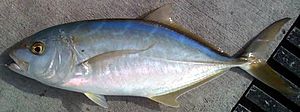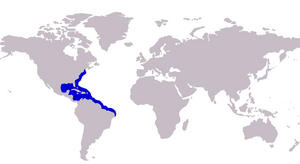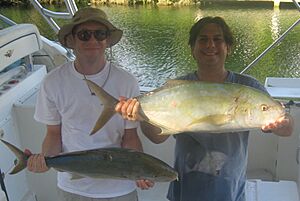Yellow jack facts for kids
Quick facts for kids Yellow jack |
|
|---|---|
 |
|
| Conservation status | |
| Scientific classification | |
 |
|
| Approximate range of the yellow jack | |
| Synonyms | |
|
The yellow jack (scientific name: Carangoides bartholomaei), also called coolihoo, is a type of ocean fish. It belongs to the jack family, known as Carangidae. This fish is one of only two species from its group found in the Atlantic Ocean.
Yellow jacks live along the east coast of the Americas. Their home stretches from Massachusetts in the north down to Brazil in the south. They also live around many islands far from the coast. You can tell a yellow jack apart from similar fish by looking at its jaw length. Also, the number of rays in its fins helps identify it.
This is a fairly large fish. It can grow up to 1 metre (39 in) long and weigh at least 14 kilograms (31 lb). Yellow jacks often live near reefs. They can swim alone or in groups called schools. They are predatory fish, meaning they hunt other small fish. Studies show that yellow jacks become ready to reproduce when they are between 23 and 32 centimetres (9.1 and 12.6 in) long. They lay their eggs in offshore waters from February to October.
Yellow jacks are not a major fishing target. However, people do catch them with hooks and nets. They are considered good to eat. Anglers often catch them from boats, but they are sometimes overlooked for bigger fish.
Contents
About the Yellow Jack Fish Name
The yellow jack is part of the Carangoides group of fish. These fish are often called jacks or trevallies. The Carangoides group is in the jack and horse mackerel family, Carangidae. The Carangidae family is part of the larger order called Carangiformes.
A famous French taxonomist named Georges Cuvier first described this fish scientifically in 1833. He based his description on a sample collected from St. Bartholomew Island in the West Indies. Cuvier named the new species Caranx bartholomaei after the island.
Scientists have debated which group (genus) this fish should belong to. Some still place it in Caranx, while others put it in Carangoides. This article follows the classification that calls it Carangoides bartholomaei. The common name "yellow jack" comes from the yellow color the fish develops as it gets older. Other names for it include "coolihoo." Sometimes, it is incorrectly called "green jack."
What Does a Yellow Jack Look Like?
The yellow jack has a body shape typical of its group. It is somewhat deep and flattened from side to side. Its back (dorsal) side is a bit more rounded than its belly (ventral) side. This is a large fish. It can grow up to 1 metre (39 in) long, but it is more commonly seen under 45 centimetres (18 in). It can weigh up to 14 kilograms (31 lb).
The top of its head curves gently from its snout to its neck. Its eye has a well-developed fatty eyelid. A key feature to identify it is that its upper jaw does not reach the front edge of its eye. Both jaws have narrow bands of tiny, brush-like teeth. These bands are wider at the front of the mouth.
The dorsal fin on its back has two parts. The first part has 7 stiff spines. The second part has 1 spine and 25 to 28 soft rays. The anal fin on its belly is similar to the second dorsal fin. It has two separate spines at the front, followed by 1 spine and 21 to 24 soft rays. The tips of the dorsal and anal fins are slightly pointed. The pectoral fin on its side is curved like a sickle and is longer than its head.
The lateral line on its side has a gentle curve at the front. This curved part is longer than the straight part at the back. The straight part of the lateral line has 22 to 28 tough scales called scutes. The rest of its body is covered in smooth scales. Its chest is fully scaled. The narrow part of its tail (caudal peduncle) has two ridges on each side. It has 24 vertebrae (backbones) and 24 to 30 gill rakers, which help it filter food.
The yellow jack is pale yellow-green-blue on its back. Its underside is silver. Young yellow jacks have about 5 dark stripes that run up and down their bodies. These stripes fade into blotches and then disappear as the fish grows older. All its fins are clear, often with a golden-brown tint. Older fish tend to be more yellow, and very large ones can have bright yellow fins.
Where Yellow Jacks Live
The yellow jack lives in the warm, tropical and subtropical western Atlantic Ocean. Along the coast of America, it ranges from Massachusetts to Maceio, Brazil. This fish also lives around hundreds of islands in the eastern Atlantic. These include Bermuda, the Bahamas, the West Indies, and throughout the Caribbean Sea.
The yellow jack and the bar jack (Carangoides ruber) are the only two species of Carangoides found in the Atlantic. All other species in this group live in the Indo-Pacific region. Yellow jacks can also be found in the Mediterranean Sea, off the coast of Libya.
While sometimes found close to shore, yellow jacks prefer offshore reefs and islands. They also live in open ocean waters over the continental shelf. Although they are not often seen in shallow waters near the American continent, yellow jacks are common in the sandy shallows of many Caribbean islands. Here, they often search for food with other fish species.
Yellow Jack Behavior and Life Cycle
Yellow jacks are predatory fish. They swim alone or in small groups. Their main prey is small fish. However, people have also seen them eating smaller creatures that live on the ocean floor.
Yellow jacks have been seen "following" larger species. They do this to take advantage of the disturbance caused by the bigger fish. This allows the yellow jack to easily find food or eat scraps left behind. They follow other fish, eels, stingrays, and even nurse sharks. In one case, they followed a flying gurnard, which is smaller than the jack. The gurnard stirred up the ocean floor, making hidden organisms available for the jack to eat. Larger yellow jacks have also been observed as the "followed" species.
This fish has also been seen living closely with spinner dolphins. They feed on the dolphin's waste products. Other types of jacks in the region also show this behavior.
Yellow jacks become mature at different sizes depending on where they live. Studies near Cuba show males are ready to reproduce at 30 centimetres (12 in) and females at 32 centimetres (13 in). In Jamaica, males become mature at 23 centimetres (9.1 in).
Spawning (laying eggs) happens in offshore waters between February and October. Observations in Belize show that while male and female yellow jacks court in pairs, they lay eggs in groups. They gather in large balls of about 300 fish. Spawning mostly happens before sunset.
Young yellow jacks live near the ocean surface. They often hide among large mats of jellyfish or Sargassum seaweed. Their coloration helps them blend in with the seaweed. These young fish are often carried long distances by the Gulf Stream. This current likely explains why yellow jacks are found as far north as Massachusetts.
Yellow Jacks and Humans
Yellow jacks are a minor commercial species where they live. They are caught using large nets (seines), dragging nets (trawls), and hook and line. Recreational fishermen also catch them with bait and lures, often while trolling. However, they are rarely the main target for these fishermen.
The yellow jack is considered a fair to good table fish. It is sold both fresh and salted. Yellow jacks are known to carry ciguatera toxins in the West Indies. This makes them a high-risk species for this type of food poisoning. Because they are predators, the toxin can build up in their bodies. The yellow jack was the first fish outside the Pacific Ocean confirmed to carry ciguatera toxins. Early studies showed that this toxin was slightly different from the Pacific version.
Images for kids
See also
 In Spanish: Carangoides bartholomaei para niños
In Spanish: Carangoides bartholomaei para niños





